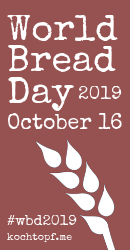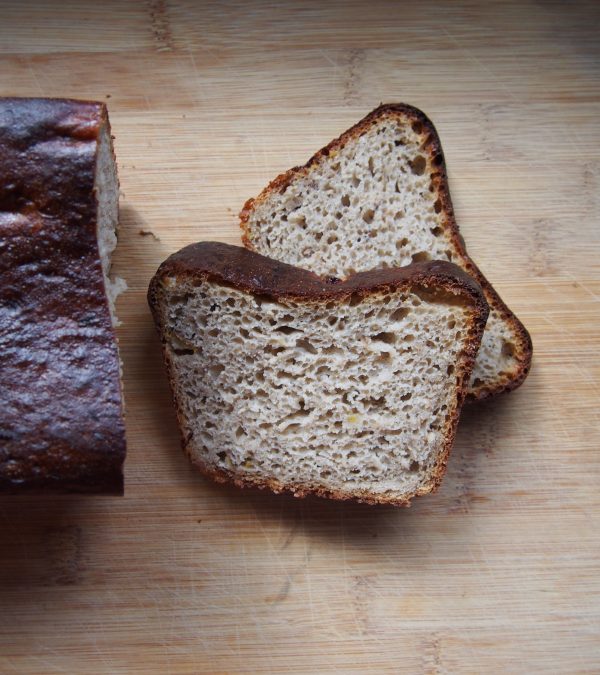Kolejny WBD nam na blogu nastał. Jak co rok miałam pustkę w głowie, co upiec; jak co rok chciałam coś innego, może nowego, może dawno nie próbowanego, a najlepiej – sezonowego. Ponieważ była już na blogu chlebowa dynia i jabłka, padło na jeszcze jeden jesienny owoc: gruszkę. 
Przepis na chleb na zakwasie z dodatkiem startej gruszki znalazłam na tym blogu. Spodobał mi się dodatek owocu w samym zaczynie (pomysł na przyspieszenie fermentacji jak u Katrii-Seldonenko – patrz moje uwagi przy chlebku wielkanocnym) i potem cieście właściwym, jednak choć w składnikach zmieniłam tylko trochę proporcje, wydłużyłam czas wyrastania na obydwu etapach, bo w oryginale był moim zdaniem zdecydowanie za krótki. Jeśli chodzi zaś o te proporcje, mój chleb ma ciasto luźne i jest przeznaczony do pieczenia w foremce – w gruncie rzeczy w smaku to wariant ulubionego pszenno-żytniego tzw. staropolskiego. Gdybyście chcieli upiec bochenek formowany luzem, trzeba lekko zredukować ilość wody i ew. miąższu owocowego.
Składniki (1 bochenek):
Zaczyn:
- 55 g dojrzałego zakwasu żytniego
- 100 g mąki żytniej jasnej (720)
- 90 g letniej wody
- 165 g startej na tarce, dojrzałej gruszki (ze skórką)
Ciasto właściwe:
- zaczyn jw.
- 140 g mąki pszennej chlebowej
- 250 g mąki żytniej typu 720
- 100g startej na tarce lub drobno posiekanej gruszki jw.
- 145 g letniej wody
- 1/2 łyżki octu jabłkowego
- 2 łyżeczki soli
Wieczorem w przeddzień dnia pieczenia wymieszać w misce składniki zaczynu, nakryć folią, odstawić najlepiej na ok. 12-15h (lub minimum 10) w temp. pokojowej. Wymieszać zaczyn z wodą, mąką i gruszką, lekko wyrobić, dodać ocet i sól, wyrobić gładkie, dość luźne ciasto. Odstawić do wyrastania na ok. 60–75 minut. Przełożyć do natłuszczonej formy (długiej keksówki), wierzch chleba wyrównać i posmarować olejem, nakryć i odstawić do drugiego wyrastania na ok. 2,5–3h. Piec z parą w 220 st. C (termoobieg) przez ok. 30 minut, następnie skręcić temperaturę do 200 st. i piec dalsze 20–30 minut, lub aż bochenek postukany od spodu będzie wydawał głuchy dźwięk. Pod koniec pieczenia można chleb wyjąć z formy i piec luzem.

Another year gone means another WBD on the blog. It also means that dilemma: what to bake? Something old (probably not), something new (yes, please)… something in season. Well, I’d already done pumpkins and apples, so this time it was pear time.
I found the recipe for this unusual pear sourdough loaf on this blog. I liked the idea of adding some fresh fruit to the starter (the idea of boosting fermentation with some ripe fruit is a bit similar to the banana in Katrya-Seldonenko’s lievito madre behind the pascha recipe – also check out the baking process on her Instagram) and final dough; however, although I only changed the ingredient ratio slightly with no omissions etc., I did lengthen the proving time for both stages, as it was much too short in the original version in my opinion. When it comes to dough texture re: the above mentioned ingredient ratio – my bread dough is quite wet and so meant to be baked in a tin (as a take on my favourite ‘old Polish’ wheat-rye). If you’d prefer a free-form loaf, you need to reduce the amount of water and possibly also grated fruit.
Ingredients (1 loaf):
Starter:
- 55 g active rye culture
- 100 g light rye flour
- 90 g lukewarm water
- 165 g (around 1 pear) unpeeled ripe pear flesh, grated
Final dough:
- starter (all of the above)
- 140 strong white flour
- 250 g light rye flour
- 100g ripe pear as above, grated or finely diced
- 145 g lukewarm water
- 1/2 łyżki cider vinegar
- 2 tsp salt
In the evening of the day preceding the baking, mix all the starter ingredients, cover well with clingfilm or similar and leave to ripen for around 12hrs (and minimum 10) in room temperature. The next day mixed the starter with the water, flour and pear, knead shortly just to roughly combine the ingredients. Add the salt and vinegar and knead till you have a smooth, sticky dough. Leave to prove for around 60-75 mins. Transfer the dough to a greased loaf tin, lightly oil the surface and cover again with e.g. clingfilm for the final rise (around 2.5–3h). Bake with normal steam for around 30 mins in 220 dgs C (fan), then lower the temperaturę to 200 dgs and bake for a further 20–30 mins, or until the loaf sounds hollow when tapped on the bottom. You may remove the bread from the pan near the end of the baking and bake it free-form for the last 10 minutes or so.



Yes, I know the dilemma – what do bake – too. You managed quite well, love your loaf. Recipe is saved! Thank you for your participation in World Bread Day!
[…] Pear sourdoughPtasia (Joanna), Coś niecośWheat-rye pear sourdough, made with a rye starter and some grated pear flesh. Moist and fairly sour-tasting (in a good way!). […]